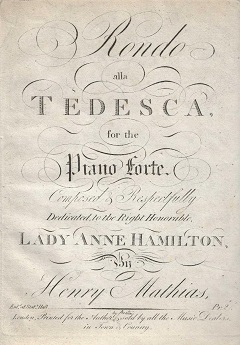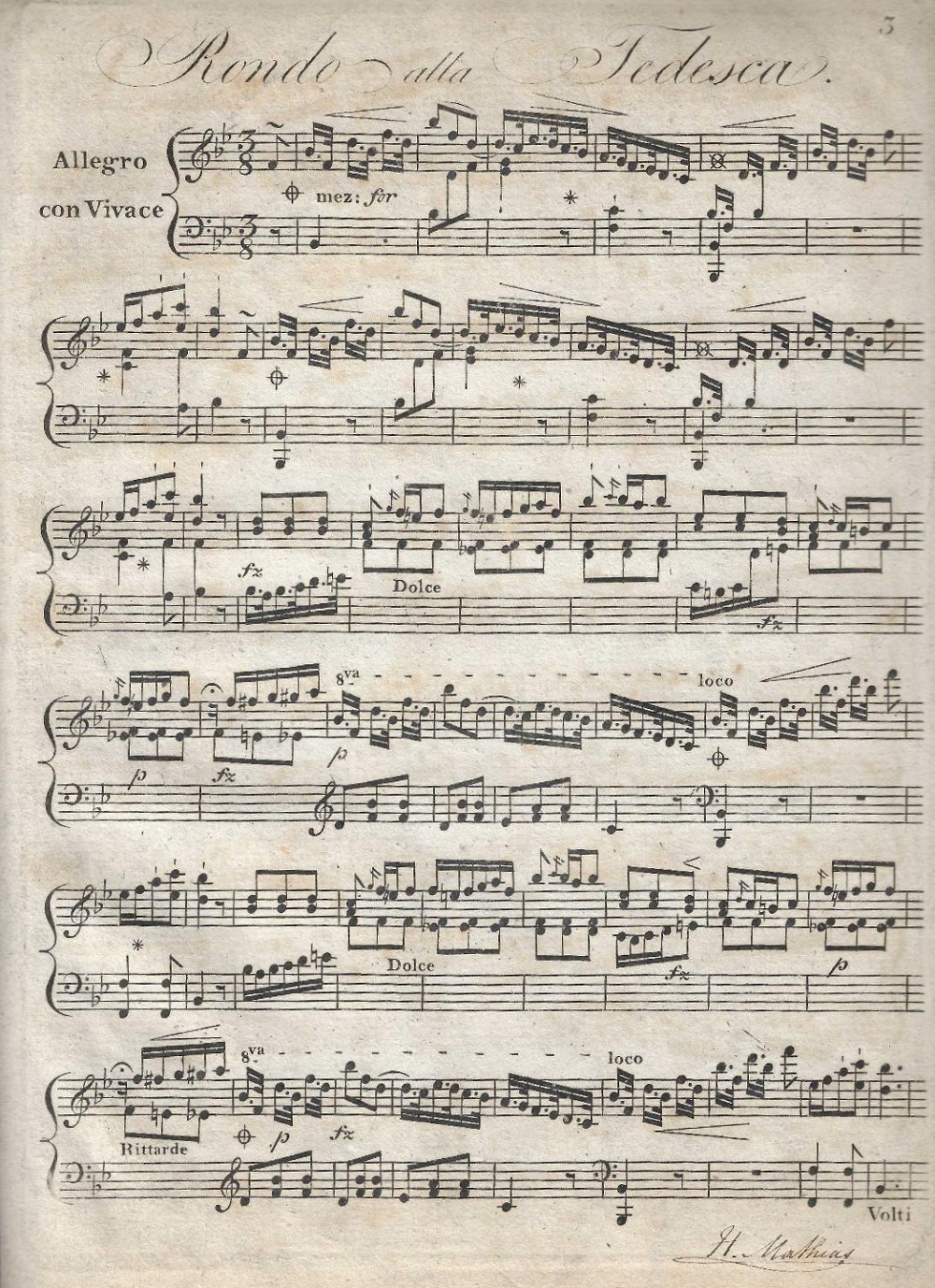“Zoom In and Find Out”: How a ‘Smart’ Painting Reveals Two Piano Works From London 1806
Sebastian Biesold
Thursday, August 7, 2025

Sheet music and musical notation in visual art can be many things: the attribute of a musician, composer, or performer, as well as a pictorial element used to suggest a context of music or simply to depict a setting of music-making. But the level of accuracy varies widely, ranging from generic single leaves or bound volumes and non-readable scribbles to the representation of actual musical works. The documentation of such music-related imagery is one of the core aims of the Répertoire International d’Iconographie Musicale (RIdIM; see also the website of the German National Branch). A recently catalogued discovery of this kind concerns a small-format watercolor by the English artist John Smart (1741–1811), painted in 1806 and now held by the Victoria and Albert Museum in London (RIdIM ID no. 9852; explore the artwork online at V&A Collections, with image viewer and zoom-in option).
The painting, a horizontal oval, portrays two young ladies at a (Broadwood?)[1] pianoforte: the elder, seated at the keyboard, is Elizabeth Binny (or Binney), while her younger sister Harriet sits just behind her. Both are dressed in the fashion of the day wearing high-waisted gowns in the Regency style. The composition lacks any elaborate background decoration, except for a pale green curtain casually draped to one side. Suggested is an intimate setting referring to the overall subject of domestic, amateur music-making in early 19th-century England, as was common among those of genteel upbringing. The sheet music on the instrument’s music stand is open to the first page of a piece on the right-hand side with a blank page on the left. In Elizabeth’s right hand, a single leaf of sheet music rests in her lap, while her left hand gently touches the keyboard, pressing down a key with her thumb. The detail and legibility of the notation and paratexts – especially in the case of the piece on the stand – raised the question: are these fictional, or could they indeed represent real, identifiable works?
Thanks to a high-resolution digital image, it became possible to zoom in and examine the painting closely. Further investigation of the sheet music on the stand revealed that the faintly readable title at the top of the page appears to identify the composition as a “Rondo alla Tedesca”. Given the title and the context provided by the image, one plausible match emerged: Rondo alla Tedesca, for the Piano Forte by a composer named Henry Mathias and dedicated to Lady Anne Hamilton; the entry for the printed edition in the copyright register at Stationers’ Hall, London, is dated 11 November of – nota bene –1806 (RISM Catalog | RISM Online).

The result of the side-by-side comparison is fascinating. Owing to Smart’s ability to capture the essential characteristics of the notation – such as melody lines, repetitions, single crotchets or single-crotchet octaves, beaming patterns and stem directions, rests, and empty bars – all with the typical precision known from his miniatures, yet without getting lost in every tiny little dot or stroke, the identification could ultimately be confirmed. Additional support comes from the secondary parameters: the tempo marking, dynamics – including crescendo and decrescendo hairpins – and performance indications, although some merely reproduce their visual impression. Moreover, it is exciting to see that not only the scriptorial representation of the musical composition is depicted but also the exact printed edition from 1806. Details such as the number of sheets, the styling of the title, and even the bar arrangements and system breaks appear in perfect alignment with the original. Another compelling example of the, so to speak, near-photographic rendering is the careful reproduction of the notational variation between bars 21 and 37, which are otherwise identical. The only notable deviation is the last system, borrowed from the next page of the print to fill the remaining space.
Henry Mathias, however, remains an obscure figure. In addition to the Rondo alla tedesca – his, now, first ever entry in RISM – two further London prints with piano compositions by him can be identified: a set of variations on a traditional Welsh folk tune called The Welsh Whim (1807, alternatively also for harp; dedicated to Lady [Jane?] Porter), and Eight Waltzes (1808, dedicated to Lady Mary Taylor).[2] There are indications that he may have been connected to Wales – particularly to Haverfordwest in Pembrokeshire – where the name Mathias frequently appears in various local historical contexts. For example, two individuals named Henry Mathias are recorded in this area during the relevant period: one, Sir Henry Mathias, lived from 1756 to 1832 and held offices as Mayor of Haverfordwest and High Sheriff of Pembrokeshire; the other, born in 1776 in Cartlett, Haverfordwest, died in 1809 at the age of 32.[3] Based on the dates of publication, age profile, and the character of the dedications, the younger of the two – if either – is more likely to correspond to the composer. His choice of The Welsh Whim may therefore have been a conscious reference to his regional origin; likewise, the Rondo alla tedesca could possibly be a reminiscence of his family’s German roots.
The second piece in the painting is easier to identify, thanks to an inscription, which reads “Weolfl [sic] op. 36.” This refers to the Grand Sonata, for the Piano Forte op. 36 by Joseph Woelfl (1773–1812), published in London by Lavenu & Mitchell and entered at Stationers’ Hall on 31 March of – again – 1806 (RISM Catalog | RISM Online). Although some legible notation is visible on the sheet, in this case it bears no identifiable resemblance to the original and appears to serve primarily an illustrative purpose. Still, its placement close to Elizabeth may hold biographical significance. Woelfl, who was born in Salzburg and received his early musical training within the Mozart family, had travelled widely across central Europe and settled in London in 1805. There, too, he established himself as a pianist, composer, and teacher. Among his students was likely the young Elizabeth Binny herself. Indeed, Woelfl would later dedicate his Non plus ultra sonata op. 41 – a work that concludes with highly virtuosic variations on “Life let us cherish” (originally “Freut euch des Lebens”) – to “Miss E. Binny” (see e.g. the print by André, Offenbach: RISM Catalog | RISM Online, with digitized copy). The inclusion of the Woelfl piece in the painting may thus hint at a personal pedagogical link between composer and sitter.
For the kind collaboration on this small international project, which has brought to life a ‘snapshot’ from London’s vibrant amateur piano scene back in 1806, and is now well documented in the databases of both RISM and RIdIM, I wish to thank: Dr. Ingrid Bodsch, Dr. Martina Falletta, Sean Ferguson, Professor Dr. Margit Haider-Dechant, Susanna Kilian, Paul van Kuik, Dr. Leanne Langley, Dr. Balázs Mikusi, and Damiët Schneeweisz.
For a more detailed account, see: Sebastian Biesold, “Musical Treasures on an Early Nineteenth-Century Watercolour Painting – Identified as Henry Mathias’s Rondo alla Tedesca and Joseph Woelfl’s Grand Sonata op. 36,” in Joseph-Woelfl-Almanach 2020/2021 (Bonn: Apollon Musikoffizin, 2024), pp. 73–78.
Notes:
[1] Leanne Langley, “Pupils and Teachers: Woelfl’s Influence on Music Development in Nineteenth-Century England,” in Joseph-Woelfl-Almanach 2020/2021 (Bonn: Apollon Musikoffizin, 2024), pp. 235–46: 238.
[2] Copies held, e.g., in GB-Lbl, Hirsch M.1282.(13.), and GB-Lbl, h.118.(18.), respectively; see Music Entries at Stationers’ Hall, 1710–1818, compiled by Michael Kassler from lists prepared for William Hawes, D. W. Krummel, and Alan Tyson and from other sources, with a foreword by D. W. Krummel, Aldershot: Ashgate, 2004, pp. 583 and 613.
[3] See the respective online entries on wikitree.com and genealogy.links.org (accessed 22 July 2025).
Images:
Title page and p. 3 of Henry Mathias, Rondo alla Tedesca, London: for the author by Preston, [1806]. D-BNwh, WHS 2022/3. © Woelfl Haus, Bonn. Reproduced with permission.
Share Tweet EmailCategory: Rediscovered

